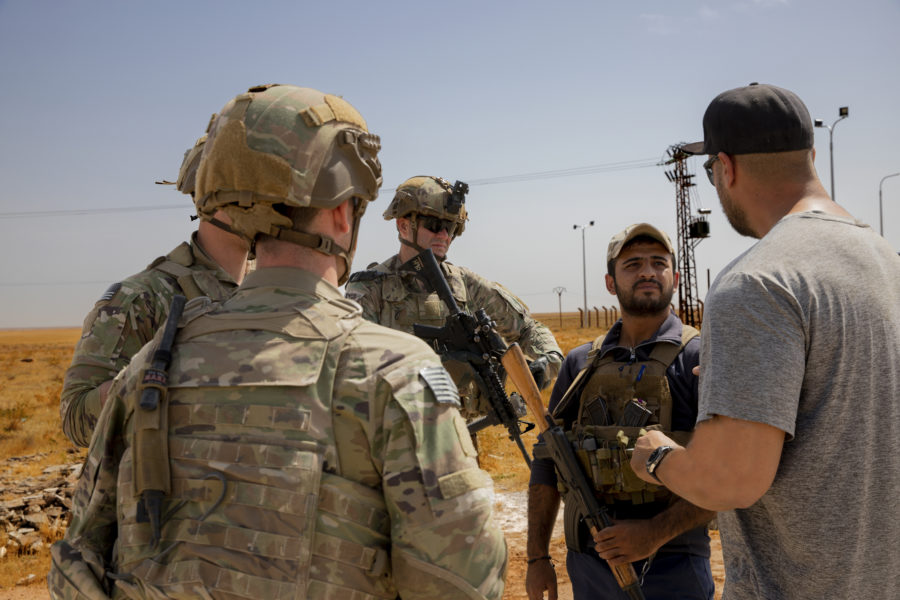The U.S. Air Force stuck two Iranian-backed militia sites in Syria early on the morning of March 24 local time, responding to a drone attack that killed a U.S. contractor in northeastern Syria the previous day, the Pentagon said. The militia attacks are the latest in an escalating series of drone and missile strikes the U.S. blames on Iran-backed groups in Iraq and Syria. Iranian-backed forces have attacked U.S. troops in Syria around 80 times since the start of 2021, according to American accounts.
“We don’t seek conflict or war with Iran,” Pentagon Press Secretary Patrick S. Ryder told reporters. “Our focus in Syria is on the enduring defeat of ISIS. Unfortunately, what you see in this situation are these Iranian-backed groups—not only in Syria but conducting operations in the Strait of Hormuz, in the Gulf, in Iraq—conducting destabilizing operations that are meant to export terror and instability.”
The March 23 militia attack that killed a U.S. contractor also wounded five U.S. service members and another U.S. contractor. The one-way drone strike hit a facility in Hasakah, Syria at 1:38 p.m. local time, according to the Pentagon. U.S. intelligence officials said the drone was made in Iran and launched by a group sponsored by Iran’s Islamic Revolutionary Guard Corps (IRGC).
President Joe Biden was briefed on the attack on U.S. personnel while aboard Air Force One on his way to Canada, U.S. officials said. Biden ordered the air strikes, which the Pentagon called a “proportionate” response.
More than 12 hours after the attack, two F-15E Strike Eagles assigned to Air Forces Central (AFCENT) launched a nighttime strike against two “IRGC-affiliated facilities” in eastern Syria at around 2:40 am, which Biden later described as sites used for munitions storage and command and control. The Pentagon said the F-15s took off from a base in the CENTCOM region but did not specify exactly which one.
“Be prepared for us to act forcefully to protect our people,” Biden said in Ottawa March 24.
The U.S. launched the airstrikes not only because of the casualties suffered March 23, but because that incident was part of a “series of recent attacks against coalition forces in Syria by groups affiliated with the IRGC,” Secretary of Defense Lloyd J. Austin III said in a statement. Around 900 U.S. forces are in Syria assisting local groups in the battle against ISIS militants.
“These precision strikes are intended to protect and defend U.S. personnel,” Austin said. “The United States took proportionate and deliberate action intended to limit the risk of escalation and minimize casualties.”
That did not end matters. Iranian-backed groups retaliated with four attacks on U.S. sites in Syria after the U.S. air stirkes.
The first of those four took place at Green Village, in northeastern Syria at 8:05 am local time March 24, the U.S. military said. According to CENTCOM, the rockets missed Green Village by around 5 kilometers and caused “significant damage” to a local house and injured four civilians, including two children.
U.S. military officials said there were three more attacks. At 10:39 pm local time on March 24, rockets hit Mission Support Site Conoco, injuring one U.S. service member, who was described as in stable condition. Less than an hour later at 11:23 pm local time, three drones targetted Green Village. Two of the drones were taken down by the sites air defenses, but one got through. It struck a building but did not cause significant damage or injure personnel. At 2:19 am local March 25 another drone targeted and struck Green Village, but did not cause any injuries.
Gen. Michael “Erik” Kurilla, the commander of CENTCOM, told the House Armed Services Committee March 23 that Iranian-backed forces have attacked American troops 78 times since the beginning of 2021. That testimony came before the most recent attacks came to light. U.S. personnel are typically not physically harmed by those attacks, as the rockets, missiles, and drones are usually shot down, miss, or only do minor damage.
However, U.S. defenses were unable to stop the deadly attack near Hasakah.
“My understanding is that there was a complete sight picture in terms of radar,” Ryder said. He said CENTCOM will review the incident to determine “what, if any, other type of mitigating actions need to be taken.”
AFCENT commander Lt. Gen. Alexus G. Grynkewich has said the Iranian threat is a vast and complex one, posing serious dilemmas for U.S. forces in the region with potential for “thousands of ballistic missiles” and other aerial threats that AFCENT and U.S. partners are working to combat.
Kurilla said during his Congressional testimony that “Iran of today is exponentially more militarily capable than it was even five years ago,” fielding the region’s largest drone and missile force.
“What Iran does to hide its hand is they use Iranian proxies … to be able to attack our forces in Iraq or Syria,” Kurilla said.
John Kirby, the strategic communications coordinator for the National Security Council, did not say whether there would be more U.S. air strikes in response to the additional militia attacks.
“We’re going to see where this goes,” Kirby said on CBS’s Face the Nation March 26. “I’m certainly not going to rule out additional U.S. action if the president deems it appropriate.”
This article was updated March 26 after U.S. officials provided details of additional attacks on U.S. forces.
